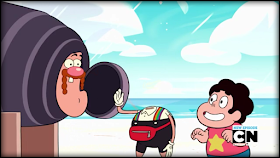I haven't read more than a handful of Clive Barker's prose works, so I know of his Hellraiser and Nightbreed concepts only through their incarnations in the cinema, where Barker's control of the franchises was, to say the least, compromised. I've read a handful of the Nightbreed comics published by Marvel's Epic line, and none of the Hellraiser comics from the same source. Fortunately, Epic's 1991 Hellraiser-Nightbreed crossover, JIHAD, is not tied into any of other serials, and neither writer D.G. Chichester nor artist Paul Johnson worked on either of the ongoing titles. Unlike some other Epic Comics graphic novels-- notably, the debut issue of VOID INDIGO-- JIHAD can be read without reference to any other serials. Admittedly, though, one is likely to be lost if one hasn't seen both the 1990 NIGHTBREED film and at least the first two Hellraiser films, which I have reviewed here and here. Indeed, I was thinking largely of JIHAD when I wrote in the second review that "HELLBOUND, while far from a perfect film, expanded on the Cenobite mythology originated by Barker, and arguably, it is the Randel-Atkins mythology that has been most fruitful in other adaptations of the franchise." (Note: Peter Atkins, writer of HELLBOUND, gets the honor of having a denizen of the Cenobite Hell named after him in JIHAD.)
Since JIHAD shows a febrile creativity in terms of both script and art, I will speak of it as the joint creation of Johnson and Chichester. The two creators had a formidable challenge before them, for of the two franchises, only Hellraiser had proved popular with horror-fans, while the NIGHTBREED film proved itself a critical and commercial failure when it debuted in American theaters in February 1990. This meant that the Nightbreed characters-- and JIHAD features a quite unwieldly quantity of them-- probably weren't really that familiar to JIHAD's readers, unless they also followed the ongoing NIGHTBREED comic book, which began a couple of months after the film's release in 1990. Still, the society of freaks and monsters who made up the Nightbreed offered more potential for reader-identification than the Cenobites from the Hellraiser franchise. These characters-- almost always represented by their articulate leader "Pinhead"-- existed largely to tempt their victims into entering their hellish domain, where they would then undergo ceaseless tortures in what might best be described as a S-&-M updating of medieval stories of infernal punishments.
So Johnson and Chichester essentially interwove the very loose "Randel-Atkins mythology" of the second Hellraiser film into the equally loose mythos created by Barker for the Nightbreed film. The result is one very heavily layered crossover, in which the Cenobites are discovered to have been the forces that caused the monstrous Nightbreed race to be divorced from their somewhat distant cousins, the human beings. I should note that Barker's concept for the Nightbreed bears a strong resemblance to the Stan Lee-Jack Kirby "Inhumans" franchise, in that both groups are comprised of a motley crew of superhumans who have little if any physical resemblance to one another-- though of course, Barker's concept ratchets up the sex, violence and perversity far beyond the boundaries of any mainstream comic book.
Despite all the transgressive elements in JIHAD, however, Johnson and Chichester bring an artfulness to their franchise-crossover. I for one consider that its theme is at least as deep as that of the Moore-Gibbons WATCHMEN, but would concede that JIHAD's space limitations-- consisting of just two 48-page novels, with gorgeously grotesque painted art by Johnson-- might make some overlook it as just another desultory franchise-crossover. I'll be exploring said theme in more depth elsewhere.
As an odd coda to this overlooked work, both Chichester and Johnson left the medium of comic books for employment in other artistic venues.

